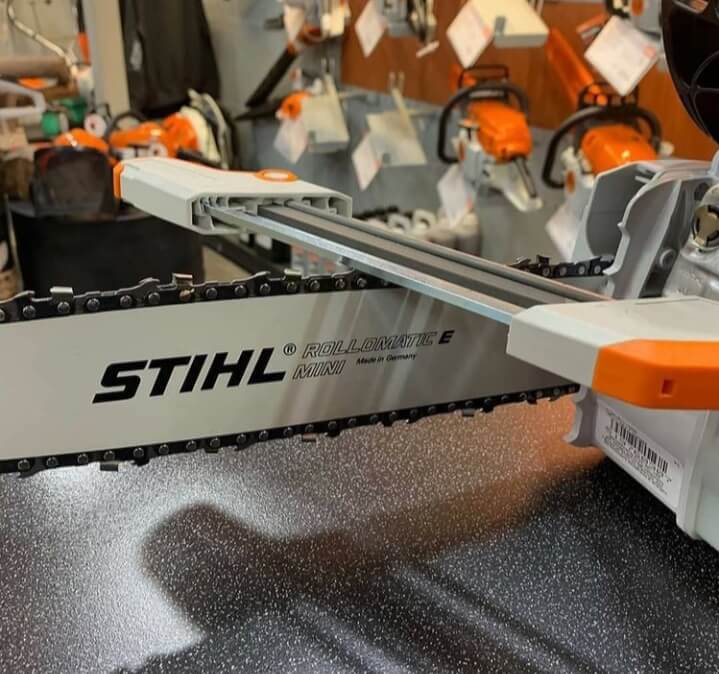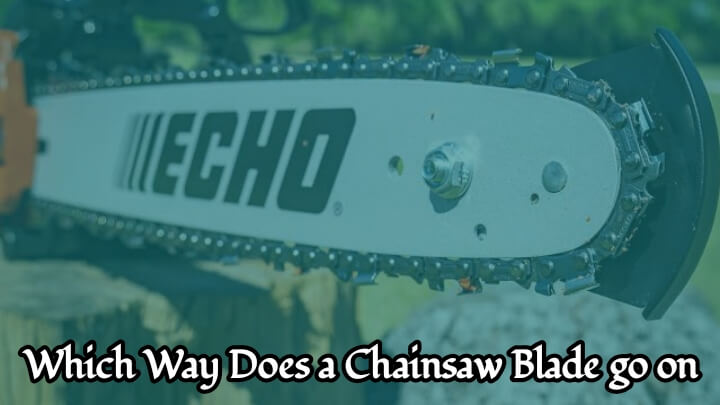People often wonder Which Way Does A Chainsaw Blade Go On.
The way that a chainsaw blade is spinning can be determined by examining the teeth on the blade. On one side of the chain, there will be small “teeth,” and on the other side of the chain, there will be larger “teeth.”
A chainsaw that cuts with its left hand would have an even number of teeth on each side. An example is a chainsaw with 20 or 14 teeth per inch (TPI).
A right-handed cut requires a chainsaw with an odd number of teeth per inch to make a clean cut in wood while not snagging on objects it passes through during the cut.
These left-handed chainsaws can be identified by an odd number of teeth per inch, such as 13 TPI or 15 TPI.
This means that when cutting with a correct hand tooth pattern saw blade and the wood must be fed into the spinning chain with the rotation of the blade. A right-handed tooth pattern requires rotating in a clockwise direction to cut correctly.
Therefore, when holding the running chainsaw in your hands, you should feed the lumber through the blade while it turns in a counterclockwise direction.
When using a chainsaw with “left-handed” (multi-tooth) teeth, simply put, they are generally utilized cutting wood down and do not give a smooth finish in a cutting chain.
A blade is designed to cut when it spins in one direction. Feeding the wood into the blade with the right-hand rotational pattern is correct for this saw type. Providing wood into the teeth from the opposite direction will cause more strain on your saw and risk breaking or damaging parts of your chainsaw.
You also run a higher chance of kickback which can result in serious injury to yourself, your friends/ family, and bystanders if proper precautions are not taken.
So remember that a “left-handed” or multi-tooth saw would be used for cutting down trees by pushing them into the spinning chain, while a “right-handed” or single tooth saw would be used for a cleaner, faster cut by pulling the wood into the spinning chain.
Table of Contents
How to Make a Chainsaw Blade Run in the Right Direction?
Chainsaws are powerful tools that could cause significant damage if mishandled. When assembling or disassembling, make sure to follow these steps not to allow an accident to occur:

Step 1 – Removing the Chainsaw Casing
Hold the handle firmly and slowly pull it off to remove the chainsaw casing. Be careful not to speed up, or you might lose control of it, leading to step 2. To properly get this done without losing control, don’t rush into pulling it apart from one another.
Have a friend help you if possible to have two pairs of hands. Once apart, keep them apart until all parts are removed from each hand to prevent any accidents from occurring while moving on to step 2.
Step 2 – Removing the Chain
To remove the chain safely and correctly, wear protective gear such as gloves and safety goggles which can be bought at a hardware store for a relatively cheap price (10$).
Once you have the protective equipment on, move your hands around the guides and around the chain itself to not cut you if it were to get somehow loose.
Step 3 – Identifying the Direction of the Cut
Here’s a simple trick that few people know about: when chainsaws are manufactured, they will initially be sharp. The direction of rotation comes in a clockwise motion (when looking from behind/the end with the engine at 12 o’clock).
Therefore, you should use a drop file to sharpen your blade counter-clockwise when cutting. Do this with enough pressure and force to achieve an efficient cut. This is where knowing how to handle the chainsaw comes into play properly.[1]
Step 4 – Reassembling and Tightening
The final step to assembling or disassembling a chainsaw is placing the chain back on. Do this by first putting it on the bottom guide bar, then snapping it onto the place where you can adjust its tense by using the tensioning screw located at the backside of your chainsaw’s casing.
There will be a hole in which to insert your screwdriver on some models. Make sure that when tightening down, make it tight enough so that movement isn’t easily possible but not too much so that it could damage anything.
Note: If you make any mistakes in this process, all that has to be done is disassemble everything and reassemble from the start. If you have any issues with this process but can’t seem to get it right no matter how many times you try, consult a professional at your local hardware store for assistance.
In addition, if any parts aren’t present or don’t look like what you believe should be covering a particular place, it would be best not to try and force anything in because chances are something will break eventually.
Also Read – How to Start a Flooded Chainsaw
Problems Of Putting The Chainsaw In The Wrong Direction
Many problems can happen when you put your chainsaw in the wrong direction. If you own a chainsaw and haven’t had any of these problems, then you’re fortunate, but if you have, here is what some of these problems may be:
1. Waste Of Good Bar Oil
This problem happens when the saw chain gets turned around and starts cutting backward, which causes excessive friction and heat build-up on the guide bar and sprocket.
This will wipe out bar oil quickly because this high heat is burning it up, so they advise using a cheap or synthetic bar oil for cold weather running or low rpm usage only.
2. Cause Damage To Chain Link
The chain is run backward when the saw chain cuts in the wrong direction. This also causes excessive friction and heat build-up on the guide bar and sprocket, which will cause more problems to your chain.
An excellent example of this problem would be that the drive links on the side get worn out quickly because they are constantly rubbed against each other.
3. Causes Unnecessary Strain On The Guide Bar
When cutting wood with a chainsaw, it wants to pull itself into the material you are cutting at all times. This is why it’s essential for saw operators to always stand with their feet spread apart for a better balance of body weight while operating a chainsaw.
If you put your chainsaw in reverse while cutting wood, you will put unnecessary stress on the guide bar, which can cause it to break.
4. It May Cause You To Doubt Your Skills
If you’re not experienced with chainsaws, then you might want to start by putting the saw forward and make sure that the chain is cutting correctly without any problems before putting it into reverse.
This way, once there are no more problems with a forward motion of the saw; you know that if the cutting process slows down or stops working completely when reversed, then you know what is causing it and can quickly find a solution before having severe issues with how well your saw works under all conditions.
5. Motor Deterioration
When putting a chainsaw in reverse while operating can cause extra strain on the motor and, in some cases, may lead to breakdown or even permanent damage to the electric starter.
6. Burnout Clutch
Putting your chainsaw in reverse while operating can cause extra strain on your chain brake, and in some situations, it can lead to either breaking down or burning out your chain brake.
Conclusion
So, which way do you turn a chainsaw blade? It depends on whether you are right-handed or prefer to use your left hand for specific tasks.
Most manufacturers recommend that right-handers place the top tooth of the cutting chain against the direction of rotation when tightening up the blade.
In other words, if you look at where each tooth is sharpened, place them inwards towards the center of rotation when using a right-handed chainsaw.
You may also read our articles about How to Hold Logs While Cutting with a Chainsaw and Best Professional Chainsaw.

